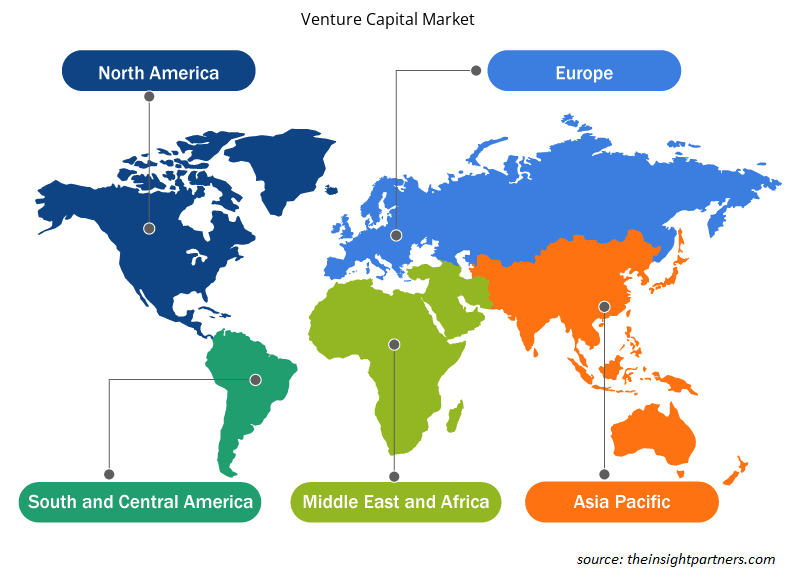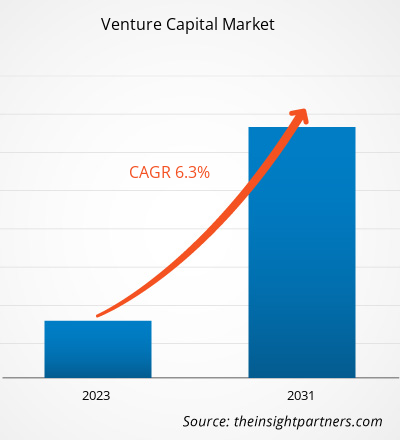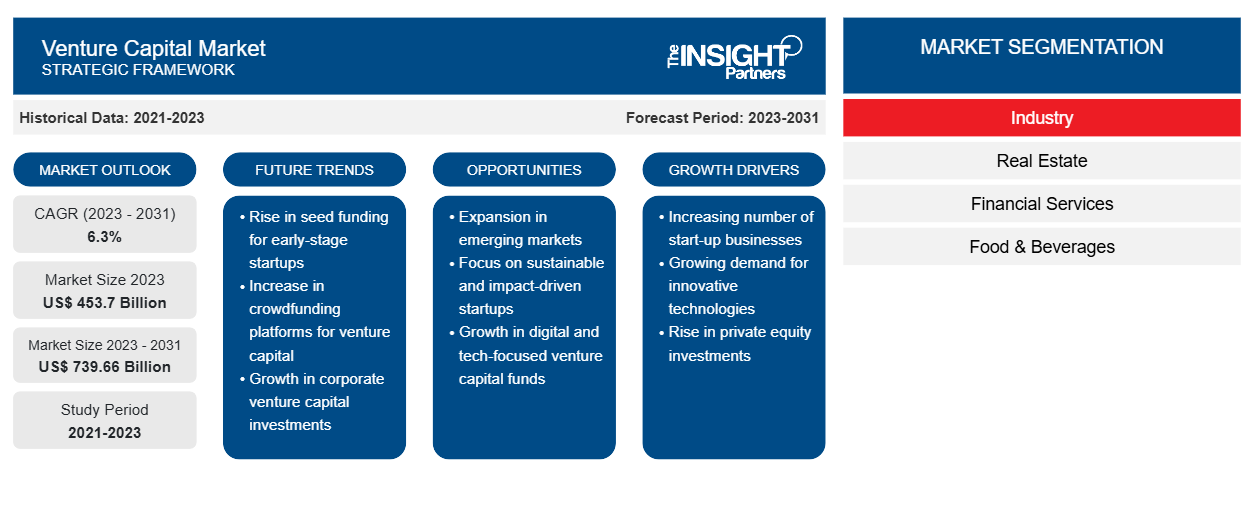Der Risikokapitalmarkt soll von 453,7 Milliarden US-Dollar im Jahr 2023 auf 739,66 Milliarden US-Dollar im Jahr 2031 wachsen; von 2023 bis 2031 wird eine durchschnittliche jährliche Wachstumsrate von 6,3 % erwartet. Der Risikokapitalmarkt bietet Wachstumsaussichten aufgrund der aktuellen Trends auf dem Risikokapitalmarkt und ihrer vorhersehbaren Auswirkungen während des Prognosezeitraums. Eine steigende Zahl von Start-ups sowie Industrialisierung und Globalisierung sind einige der Faktoren, die das Marktwachstum vorantreiben. Marktvolatilität und regulatorische Herausforderungen bremsen das Marktwachstum jedoch.
Risikokapitalmarktanalyse
Risikokapital (VC) ist eine Untergruppe von Private Equity, die Start-ups und kleine Unternehmen mit Aussicht auf nachhaltige Expansion finanziert. Investmentbanken, Finanzinstitute und Investoren sind die üblichen Risikokapitalquellen. Risikokapital (VC) finanziert Start-ups und kleine Unternehmen, von denen Investoren glauben, dass sie ein erhebliches Entwicklungspotenzial haben. Private Equity (PE) ist die übliche Finanzierungsform. Über unabhängige Kommanditgesellschaften werden Eigentumsanteile an eine ausgewählte Gruppe von Investoren verkauft. Während PE normalerweise etablierte Unternehmen finanziert, die nach einer Kapitalspritze suchen, konzentriert sich Risikokapital normalerweise auf sich entwickelnde Unternehmen. Risikokapital (VC) ist eine wichtige Finanzierungsquelle, insbesondere für Start-ups, die keinen Zugang zu Bankdarlehen, Kapitalmärkten oder anderen Formen von Schulden haben. Die drei Arten von Risikokapital sind Seed-, Early-Stage- und Late-Stage-Finanzierung.
Die Globalisierung hat sich in den letzten Jahrzehnten als Folge der Ausweitung von Handels- und Finanznetzwerken entwickelt, die nationale Grenzen überschreiten und Unternehmen und Arbeitnehmer aus anderen Volkswirtschaften immer stärker miteinander vernetzen. Eine stärkere Globalisierung schafft mehr Möglichkeiten für internationale Investitionen, was zu mehr investitionsbezogenen Programmen führt. Darüber hinaus erleichtert die Industrialisierung auch erhöhte Investitionen, länderübergreifende Kooperationen, Partnerschaften und Joint Ventures und fördert so das Wachstum des Risikokapitalmarktes.
Passen Sie diesen Bericht Ihren Anforderungen an
Sie erhalten kostenlos individuelle Anpassungen an jedem Bericht, einschließlich Teilen dieses Berichts oder einer Analyse auf Länderebene, eines Excel-Datenpakets sowie tolle Angebote und Rabatte für Start-ups und Universitäten.
-
Holen Sie sich die wichtigsten Markttrends aus diesem Bericht.Dieses KOSTENLOSE Beispiel umfasst eine Datenanalyse von Markttrends bis hin zu Schätzungen und Prognosen.
Überblick über die Risikokapitalbranche
- Risikokapital bietet finanzielle Unterstützung für Startups, denen der nötige Cashflow fehlt, um Schulden aufzunehmen. Da Investoren Eigenkapital in potenziellen Unternehmen erwerben und Unternehmen die Mittel erhalten, die sie für den Start ihrer Geschäftstätigkeit benötigen, kann diese Vereinbarung für beide Parteien von Vorteil sein.
- VCs bieten häufig Networking- und Mentoring-Dienste an, um bei der Suche nach Beratern und Talenten behilflich zu sein. Eine solide Risikokapitalfinanzierung kann Unternehmen dabei helfen, mehr Investitionen zu tätigen.
- Ein Unternehmen, das Risikokapital annimmt, kann jedoch die kreative Kontrolle über seine zukünftige Ausrichtung verlieren. Risikokapitalgeber (VCs) wollen wahrscheinlich einen beträchtlichen Anteil der Unternehmensaktien und könnten sogar Druck auf das Managementteam ausüben.
- Viele Risikokapitalgeber üben möglicherweise Druck auf das Unternehmen aus, schnell auszusteigen, da ihr Hauptziel darin besteht, schnell eine hohe Auszahlung zu erzielen.
Treiber des Risikokapitalmarktes
Steigende Zahl von Startups treibt den Risikokapitalmarkt an
- Der Zugang zu Technologie und Ressourcen sowie eine wachsende Kultur des Unternehmertums und der Innovation machen es Einzelpersonen mit Ideen leichter, diese in tragfähige Unternehmen umzusetzen. Laut SBA waren beispielsweise im Jahr 2022 in den USA 30,2 Millionen Kleinunternehmen tätig und 1.000 aktive Unicorns.
- Laut CB Insights gibt es im Januar 2024 weltweit über 1.200 Milliarden-Dollar-Einhorn-Startups. Darüber hinaus werden laut Microsoft jedes Jahr 50 Millionen neue Startups gegründet. Das bedeutet, dass im Durchschnitt jeden Tag 137.000 Startups gegründet werden.
- Immer mehr Unternehmer gründen Startups mit innovativen Ideen und suchen nach Finanzierungsmöglichkeiten, um ihr Unternehmen auszubauen.
- Risikokapitalgeber, die von der Aussicht auf hohe Renditen angezogen werden, investieren in diese Startups und erhalten dafür Eigenkapital. Dieser Kapitalzufluss fördert das Wachstum der Startups und ermöglicht ihnen, ihre Geschäftstätigkeit auszuweiten, neue Produkte zu entwickeln und neue Märkte zu erschließen.
- Da erfolgreiche Startups Gewinne für die Anleger erwirtschaften, wird mehr Kapital auf den Risikokapitalmarkt gelockt, wodurch ein Wachstumszyklus entsteht.
- Die Erfolgsgeschichten bekannter Startups treiben diesen Kreislauf zusätzlich an und inspirieren weitere Unternehmer, den Schritt zu wagen und nach Finanzierung zu suchen. Auf diese Weise wird das Wachstum des Risikokapitalmarktes vorangetrieben.
Segmentierungsanalyse des Risikokapitalmarktberichts
- Je nach Typ ist der Risikokapitalmarkt in lokale und internationale Investoren segmentiert.
- Es wird erwartet, dass das lokale Investorensegment im Jahr 2023 einen beträchtlichen Marktanteil am Risikokapital halten wird.
- Lokale Investoren verfügen häufig über ein tieferes Verständnis der lokalen Marktdynamik, der Vorschriften und der kulturellen Feinheiten, was ihnen bei der Erkennung vielversprechender Investitionsmöglichkeiten einen Vorteil verschaffen kann.
- Andererseits bringen internationale Investoren möglicherweise breitere Netzwerke, vielfältigere Perspektiven und Zugang zu größeren Kapitalpools mit, was für Startups, die weltweit expandieren möchten, von Vorteil sein kann.
Analyse der Marktanteile von Risikokapital nach geografischer Lage
Der Risikokapitalmarkt ist im Wesentlichen in fünf Regionen unterteilt: Nordamerika, Europa, Asien-Pazifik, Naher Osten und Afrika sowie Südamerika. Nordamerika erlebt ein rasantes Wachstum und wird voraussichtlich einen bedeutenden Anteil am Risikokapitalmarkt halten. Die bedeutende wirtschaftliche Entwicklung der Region, die wachsende Bevölkerung und die steigende Zahl von Startups, die Risikokapital benötigen, haben zum Wachstum des Marktes beigetragen.
Regionale Einblicke in den Risikokapitalmarkt
Die regionalen Trends und Faktoren, die den Risikokapitalmarkt im Prognosezeitraum beeinflussen, wurden von den Analysten von Insight Partners ausführlich erläutert. In diesem Abschnitt werden auch die Marktsegmente und die Geografie des Risikokapitalmarkts in Nordamerika, Europa, im asiatisch-pazifischen Raum, im Nahen Osten und Afrika sowie in Süd- und Mittelamerika erörtert.

- Erhalten Sie regionale Daten zum Risikokapitalmarkt
Umfang des Risikokapitalmarktberichts
| Berichtsattribut | Details |
|---|---|
| Marktgröße im Jahr 2023 | 453,7 Milliarden US-Dollar |
| Marktgröße bis 2031 | 739,66 Milliarden US-Dollar |
| Globale CAGR (2023 - 2031) | 6,3 % |
| Historische Daten | 2021-2023 |
| Prognosezeitraum | 2023–2031 |
| Abgedeckte Segmente |
Nach Branche
|
| Abgedeckte Regionen und Länder |
Nordamerika
|
| Marktführer und wichtige Unternehmensprofile |
|
Dichte der Akteure auf dem Risikokapitalmarkt: Die Auswirkungen auf die Geschäftsdynamik verstehen
Der Markt für Risikokapital wächst rasant. Die Folge ist eine steigende Nachfrage der Endnutzer aufgrund von Faktoren wie sich entwickelnden Verbraucherpräferenzen, technologischen Fortschritten und einem größeren Bewusstsein für die Vorteile des Produkts. Mit der steigenden Nachfrage erweitern Unternehmen ihr Angebot, entwickeln Innovationen, um die Bedürfnisse der Verbraucher zu erfüllen, und nutzen neue Trends, was das Marktwachstum weiter ankurbelt.
Die Marktteilnehmerdichte bezieht sich auf die Verteilung der Firmen oder Unternehmen, die in einem bestimmten Markt oder einer bestimmten Branche tätig sind. Sie gibt an, wie viele Wettbewerber (Marktteilnehmer) in einem bestimmten Marktraum im Verhältnis zu seiner Größe oder seinem gesamten Marktwert präsent sind.
Die wichtigsten auf dem Risikokapitalmarkt tätigen Unternehmen sind:
- Tiger Global Management
- Neue Unternehmen Associates
- Sequoia-Hauptstadt
- DST Global
- IDG Capital
Haftungsausschluss : Die oben aufgeführten Unternehmen sind nicht in einer bestimmten Reihenfolge aufgeführt.

- Überblick über die wichtigsten Akteure auf dem Risikokapitalmarkt
Die „Venture Capital Marktanalyse“wurde basierend auf Typ, Branche und Geografie durchgeführt. Auf der Grundlage des Typs ist der Markt in lokale und internationale Investoren segmentiert. Basierend auf der Branche ist der Risikokapitalmarkt in Immobilien, Finanzdienstleistungen, Lebensmittel und Getränke, Gesundheitswesen, Transport und Logistik , IT und ITeS, Bildung und andere segmentiert. Basierend auf der Geografie ist der Markt in Nordamerika, Europa, Asien-Pazifik, den Nahen Osten und Afrika sowie Südamerika segmentiert.
Neuigkeiten und aktuelle Entwicklungen auf dem Risikokapitalmarkt
Unternehmen verfolgen anorganische und organische Strategien wie Fusionen und Übernahmen auf dem Risikokapitalmarkt. Nachfolgend sind einige aktuelle wichtige Marktentwicklungen aufgeführt:
- Im November 2023 kündigte IBM die Einführung eines 500 Millionen US-Dollar schweren Risikokapitalfonds an, der in eine Reihe von KI-Unternehmen – von der Frühphase bis hin zu Hyper-Growth-Startups – investieren soll, deren Schwerpunkt auf der Beschleunigung generativer KI-Technologie und -Forschung für Unternehmen liegt.
[Quelle: IBM Corporation, Firmenwebsite]
- Im September 2023 gab Amazon Catalytic Capital bekannt, in vier neue Risikokapitalfonds investiert zu haben, womit sein Gesamtportfolio auf acht Fonds angewachsen ist.
[Quelle: Amazon, Firmenwebsite]
Bericht zum Risikokapitalmarkt: Abdeckung und Ergebnisse
Die Prognose des Risikokapitalmarktes wird auf der Grundlage verschiedener sekundärer und primärer Forschungsergebnisse geschätzt, wie z. B. wichtiger Unternehmenspublikationen, Verbandsdaten und Datenbanken. Der Marktbericht „Risikokapitalmarktgröße und -prognose (2021–2031)“ bietet eine detaillierte Analyse des Marktes, die die folgenden Bereiche abdeckt:
- Marktgröße und -prognose auf globaler, regionaler und Länderebene für alle abgedeckten wichtigen Marktsegmente.
- Marktdynamik wie Treiber, Beschränkungen und wichtige Chancen.
- Wichtige Zukunftstrends.
- Detaillierte PEST- und SWOT-Analyse
- Globale und regionale Marktanalyse, die wichtige Markttrends, wichtige Akteure, Vorschriften und aktuelle Marktentwicklungen abdeckt.
- Branchenlandschaft und Wettbewerbsanalyse, einschließlich Marktkonzentration, Heatmap-Analyse, Schlüsselakteuren und aktuellen Entwicklungen.
- Detaillierte Firmenprofile.
- Historische Analyse (2 Jahre), Basisjahr, Prognose (7 Jahre) mit CAGR
- PEST- und SWOT-Analyse
- Marktgröße Wert/Volumen – Global, Regional, Land
- Branchen- und Wettbewerbslandschaft
- Excel-Datensatz
Aktuelle Berichte
Erfahrungsberichte
Grund zum Kauf
- Fundierte Entscheidungsfindung
- Marktdynamik verstehen
- Wettbewerbsanalyse
- Kundeneinblicke
- Marktprognosen
- Risikominimierung
- Strategische Planung
- Investitionsbegründung
- Identifizierung neuer Märkte
- Verbesserung von Marketingstrategien
- Steigerung der Betriebseffizienz
- Anpassung an regulatorische Trends























 Kostenlose Probe anfordern für - Risikokapitalmarkt
Kostenlose Probe anfordern für - Risikokapitalmarkt